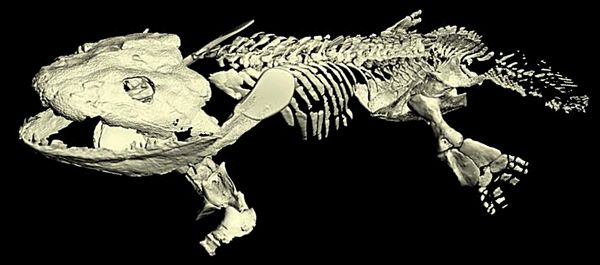Athena Review Image Archive ™
Ichthyostega

3-D model of Ichthyostega (after Clack et al.2012)
Ichthyostega was a Late Devonian amphibian found in East Greenland, dating from about 370 mya. The name means "fish roof," from Ichthyo- "fish" and -stega
"roof", referring to the skull. It belongs to the class Amphibia and
the order Ichthyostegalia, and is one of the earliest known tetrapods,
comprising a transitional group between lobe-finned fish and
amphibians.
In 1931, fourteen specimens of Ichthyostega
were collected in Famennian (Late Devonian) deposits in the Arctic
region of East Greenland by the Danish East Greenland Expedition, led
by Gunnar Säve-Söderbergh. In 1932, four distinct Ichthyostega species
were described by Säve-Söderbergh. Additional specimens were collected
in Greenland between 1933 and 1955.
Ichthyostega
was at first seen as transitional between fish and the early
Stegocephalians (“roofed heads”), an amphibian group named in 1868 by
the American paleontologist Edward Drinker Cope, for the large amounts
of dermal armor on their skulls.
The Ichthyostegalia comprises an order of early tetraforms including the genera Ichthyostega, Acanthostega, Tulerpeton, and Elginerpeton.
Ichthyostegalia contains the most basal of tetrapods which have toes
rather than fins. This includes all taxa more advanced than Tiktaalik, the closest relative of tetrapods known to have retained paired fins rather than feet (Coates and Clack 1990).
Ichthyostega is closely related to Acanthostega gunnari, also discovered in East Greenland. Ichthyostega
combined a heavily armoured stegocephalian skull with a fishlike
tail bearing fin-rays. The skull was flat with dorsally placed
eyes, and armed with large labyrinthodont teeth, with maze-like folded
enamel. The posterior margin of the skull formed an operculum covering
the gills. The spiracle was situated in an otic notch behind each
eye.
Ichthyostega`s skull is more fish-like than that of Acanthostega, but its shoulder and pelvic girdles appear stronger and better adapted to land-life. Ichthyostega also had more supportive ribs and stronger vertebrae. Ichthyostega was fairly large and broadly built, with a body length of 1.5 m. It possessed lungs and limbs that helped it navigate through shallow water in swamps, such as prevailed then in Greenland in the far warmer climate of the Late Devonian.
At the close of the Devonian, forms with progressively stronger legs and vertebrae evolved, and the later groups lacked functional gills as adults. The Ichthyostegalians were succeeded by amphibians that developed the ability to walk on land, including temnospondyls and anthracosaurs such as Eryops. The genus Ichthyostega became extinct during the Early Mississippian period.
References:
Blom, H. 2005. Taxonomic Revision Of The Late
Devonian Tetrapod Ichthyostega from East Greenland. Palaeontology, 48;
Part 1:111–134
Clack, J. et al. 2012. A computerized rendering of Ichthyostega showing limbs in active positions. Nature.
Coates and Clack 1990.
Säve-Söderbergh, G. 1932.
Copyright © 1996-2020 Rust Family Foundation (All Rights Reserved).